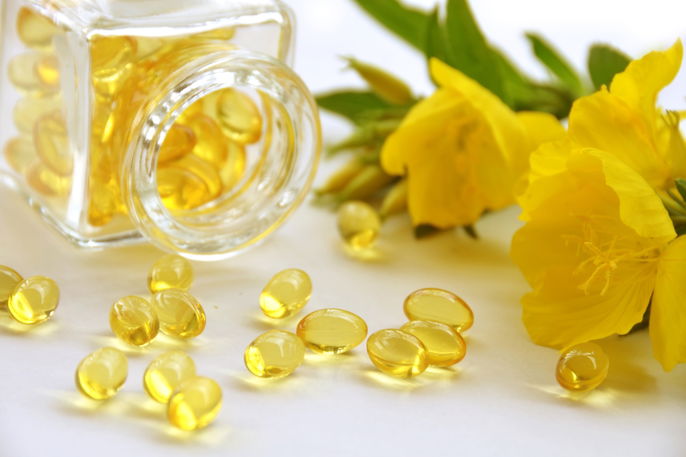What is it:
Primrose oil is a supplement that is rich in gamma-linolenic acid and fatty acids. It is often referred to a omega-6, and is commonly used to treat many inflammatory illnesses, like PMS, menopause and rheumatoid arthritis. It is also used to prevent cardiovascular disease, improve overall health and prevent hair loss.
This oil is extracted from seeds of the Oenothera biennis plant, and can be purchased at natural health stores in liquid or capsule form. You should take it as directed by a doctor or medicinal plant specialist.
To optimize the effects of primrose oil, you should take it with small doses of vitamin E, which maximizes the absorption of this supplement.

Common uses:
The main benefits, or uses, of primrose oil include:
1. Relieve PMS symptoms
Primrose oil is rich in gamma-linolenic acid (GLA), which is a type of fatty acid that is needed for the production of prostaglandin E1. Low levels of prostaglandin E1 can affect the body’s sensitivity to prolactin hormones, which are associated with PMS symptoms like bloating, breast sensitivity, irritability, depression, compulsive eating or headache.
Primrose oil can influence how the body responds to prolactin, which in turn can help relieve symptoms of PMS.
2. Reduce hot flashes
The GLA found in primrose oil can also help to reduce the frequency, intensity and duration of hot flashes caused by menopause.
One study [1] showed that hot flashes were better managed with a 500 mg dose of primrose capsules twice a day for 6 weeks. This is a great option for women looking to treat their hot flashes naturally.
3. Help to treat high blood pressure
Some studies [2,3] show that primrose oil can help to treat high blood pressure. Participants of these studies showed an overall reduction in blood pressure when 500 mg in capsule-form were taken twice a day.
It is important to note, however, that primrose oil was not effective in treating high blood pressure related to pregnancy or pre-eclampsia.
4. Prevent cardiovascular disease
A study completed in rats [4] showed that the GLA in primrose oil can help to boost "good" cholesterol levels and reduce the bad cholesterol that builds-up in the arteries. Due to its anti-inflammatory action, it can also help to prevent the development of cardiovascular diseases like atherosclerosis, heart attack or brain injury.
However, more studies in humans are needed to prove this benefit.
5. Prevent thromboses
The GLA in primrose oil has an anti-aggregate action, that helps to decrease the formation of blood clots and improve overall blood flow. It can help with the prevention of thrombosis or other cardiovascular problems, like a heart attack.
6. Improve skin health
GLA found in primrose oil acts as anti-inflammatory, which can help to boost the skin’s elasticity, moisture and firmness. Primrose oil can also treat skin redness and dryness, which is why it is often used to manage inflammatory skin diseases, like acne, eczema, psoriasis or dermatitis.
7. Prevent hair loss
Primrose oil can help to promote hair growth and prevent hair loss, due to the anti-inflammatory action of GLA. It provides more nutrients to the scalp, which reduces damage to follicles and stimulates healthy cell proliferation.
Low levels of fatty acids can also lead to hair loss, as it they are essential for healthy hair. Therefore, primrose oil can also help to prevent hair loss.
8. Complement treatment of rheumatoid arthritis
Due tu the anti-inflammatory properties in GLA, primrose oil can help reduce pain related to rheumatoid arthritis. It can be used as a complement to the medical treatment of this condition.
How to take
Primrose oil can be used in capsule or liquid form. There is no specific dosing schedule, which is why it should be taken under medical supervision.
1. Primrose oil capsules
Primrose oil capsules should be taken orally. Most manufacturers produce 500 mg capsules and advise taking one capsule once or twice per day before meals.
Duration of primrose oil treatment depends on the underlying condition to be treated, and should be directed by a doctor or medicinal plant specialist.
2. Liquid primrose oil
Liquid primrose oil can be used topically, on the skin. Before using, you should perform an allergy test by placing a drop of the oil on the skin of the inner arm. Then cover the drop for 24 hours and monitor for irritation, redness or itchiness. If allergy symptoms are noted, do not use primrose oil.
To use primrose oil on the skin, you should mix it with a base oil, like coconut oil or almond oil. Then apply the mixture to the affected skin on your scalp, making sure the skin is completely dry to optimize absoprtion. After 30 minutes, you can wash the oil off as you normally would.
Possible side effects
Although it is generally well-tolerated, primrose oil can cause side effects, especially if taken in large quantities. Some side-effects may include headache, abdominal pain, vomiting or diarrhea.
The side-effects of primrose oil applied topically are still not well known, which is why it should only be used under the supervision of a doctor or medicinal plant specialist.
Contraindications for use
Primrose oil should not be used by people with an allergy to GLA or to plants in the onagraceae family, like primrose.
This oil should only be used by children or pregnant women under the supervision of a doctor.
Primrose oil should be avoided by people with a history of epilepsy or coagulation problems, and by people who use anticoagulants or anti-inflammatories. It should not be used in combination with medications that treat mental health problems (like chlorpromazine, tioridazine and fluphenzine) and blood pressure (like losartan).






























